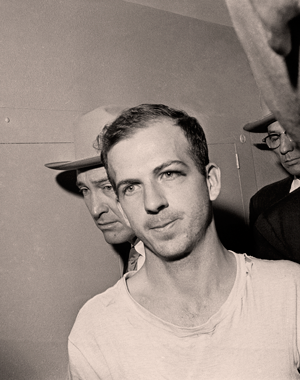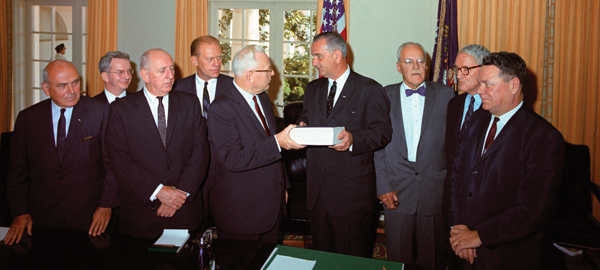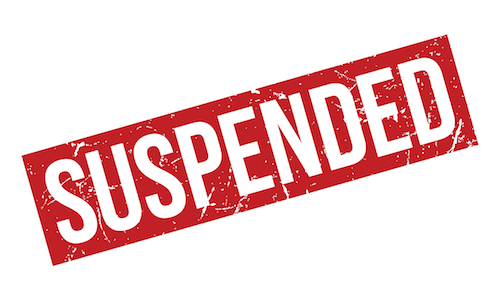Sept. 24, 1964: Warren Commission reports on John F. Kennedy's death

Lee Harvey Oswald. AP Photo.
In the agonizing days after the assassination of John F. Kennedy, it became apparent to the nation’s newly sworn president that much of what seemed so inexplicable needed to be explained. The murder of accused assassin Lee Harvey Oswald two days after his arrest had precluded any public trial, and any determination of his motive.
Glaring blunders by the FBI and the Dallas Police Department bred deep mistrust of traditional criminal investigation. Even more troubling, the sheer scale of the tragedy seemed to demand a grander conspiracy than the incongruous politics of a single troubled man. President Lyndon B. Johnson persuaded Chief Justice Earl Warren to head a bipartisan commission to investigate the murders. To work with him he appointed Sens. Richard B. Russell and John Sherman Cooper; Reps. Hale Boggs and Gerald R. Ford; former CIA Director Allen W. Dulles; and John J. McCloy, a lawyer and Johnson confidant.
By the time the commission handed over its findings on Sept. 24, 1964, its staff had compiled 26 volumes with sworn testimony from 552 witnesses, including bystanders, doctors, law enforcement officials, ballistics specialists and other forensic experts. They collected more than 3,100 exhibits and reviewed 25,000 interviews by the FBI. It was, in its time, the most extensive criminal investigation in American history.
However spectacular its volumes of documentation, its conclusions were remarkably direct: that Oswald and Jack Ruby, the man who murdered him, acted alone. But an increasingly insecure body politic received the report with begrudging acceptance or outright dismissal. And even now, more than 50 years after the fact, a majority of Americans still believe that the events of November 1963 involved a much broader conspiracy than was ever acknowledged.
The evidence against Oswald was compelling. Several witnesses saw a man with a rifle in the sixth-floor window of the Texas School Book Depository. Oswald’s prints were found on a rifle and several boxes near the window, and on a bag used to carry the rifle. Oswald signed the mail order used to purchase the rifle and posed for pictures holding it. Ballistics experts determined that bullet fragments found in the president’s car came from Oswald’s rifle. And only 45 minutes after the assassination, two witnesses saw Oswald shoot J.D. Tippit, a Dallas patrolman who had stopped to question him in a nearby neighborhood.

Chief Justice Earl Warren hands President Lyndon B. Johnson a copy of The Warren Report. Photograph By Cecil W. Stoughton. Courtesy of LBJ Library.
Still, theories of sweeping conspiracy have flourished over the decades, many of which were investigated and analyzed by the commission: that Oswald was not the assassin; that another shooter had participated; that Ruby had been part of the plot; that the conspiracy might include the CIA, Cuban intelligence, wealthy anti-communists or the KGB. But none of these allegations sustained a credible challenge to the Warren commission’s final conclusions.
In 1978, the House Select Committee on Assassinations confirmed that two of the three shots fired by Oswald had struck and killed Kennedy, but decided that a fourth bullet had been fired from another source. Even that conclusion was based on controversial acoustic evidence later found to be mistaken.
There were cover-ups. Oswald, a communist activist, was well known to the FBI. He had defected to the Soviet Union and returned to the U.S. with a Russian wife. Just weeks before the assassination, he had tried to shoot Maj. Gen. Edwin A. Walker, a well-known anti-communist zealot, at his Dallas home. Moreover, the commission discovered that the FBI had withheld embarrassing evidence of threats made by Oswald before the assassination, threats never handed over to the Secret Service.
But as spectacular as the crime had been, and as twisted as Oswald’s trail of anger seemed, the commission concluded that Oswald acted not only alone but with a remarkably mundane motive. The day before the killing, he had sought reconciliation with his estranged wife, Marina. When he departed that morning for the depository, he left behind his wedding ring and $170 in cash. He was on his way to kill the president because he had been rejected by his wife.
This article originally appeared in the September 2016 issue of the ABA Journal with this headline: “Sept. 24, 1964: The Warren Commission Reports.”



